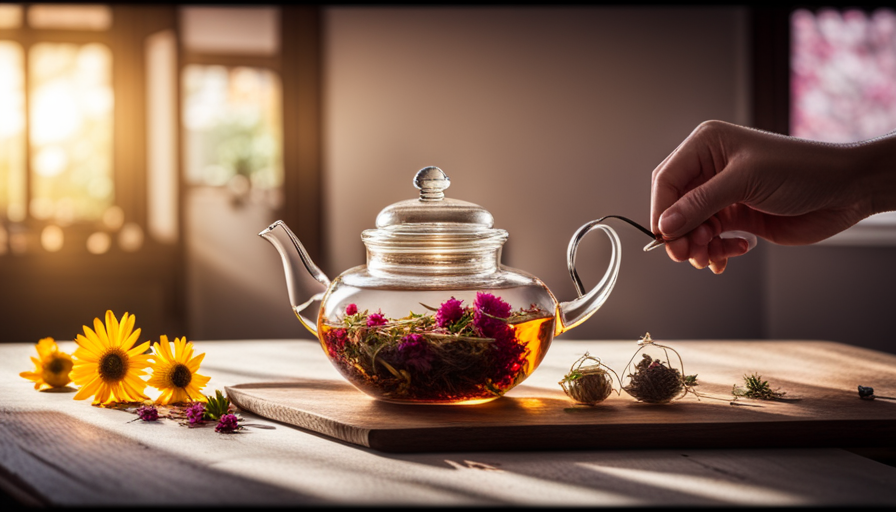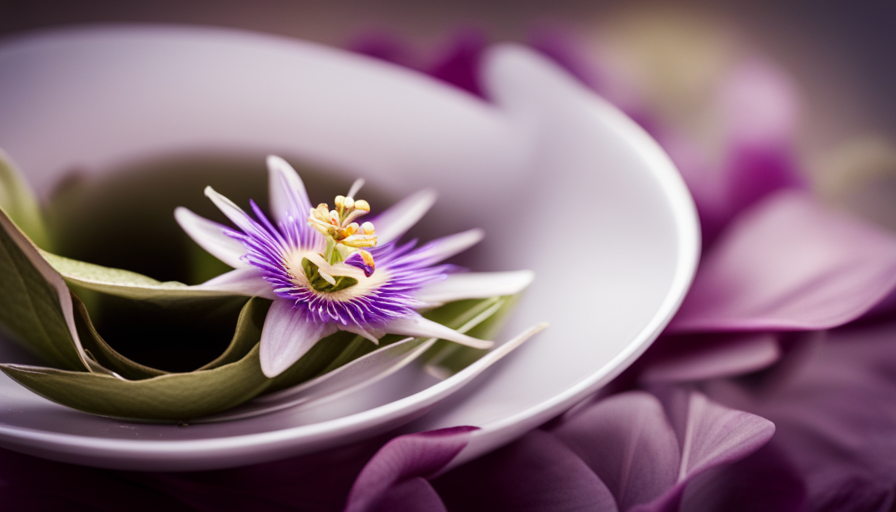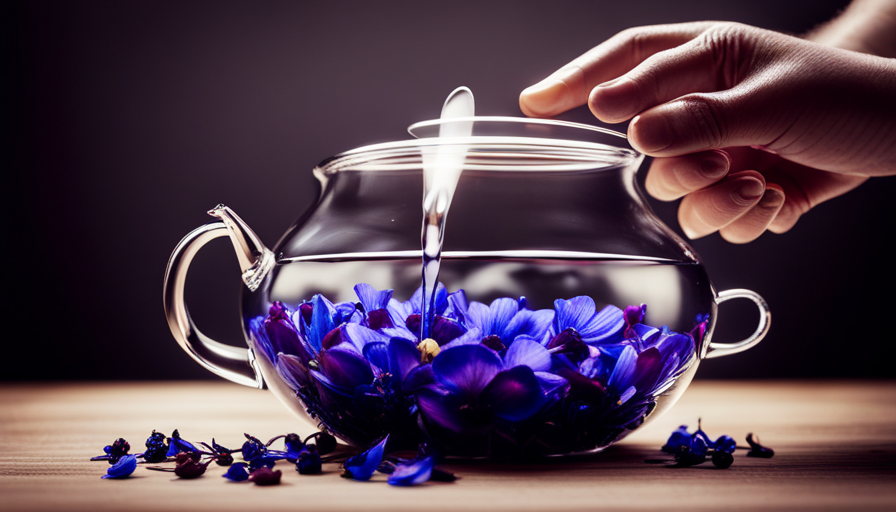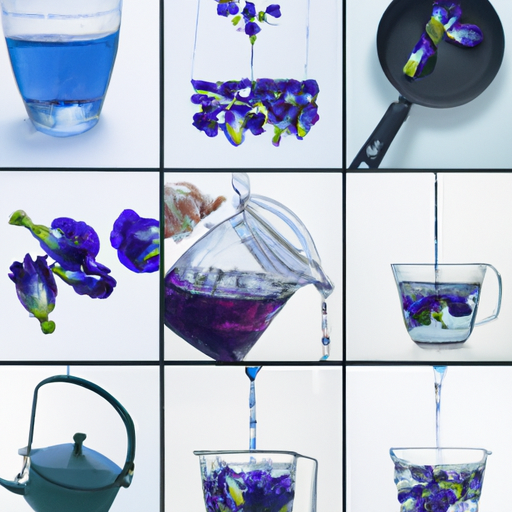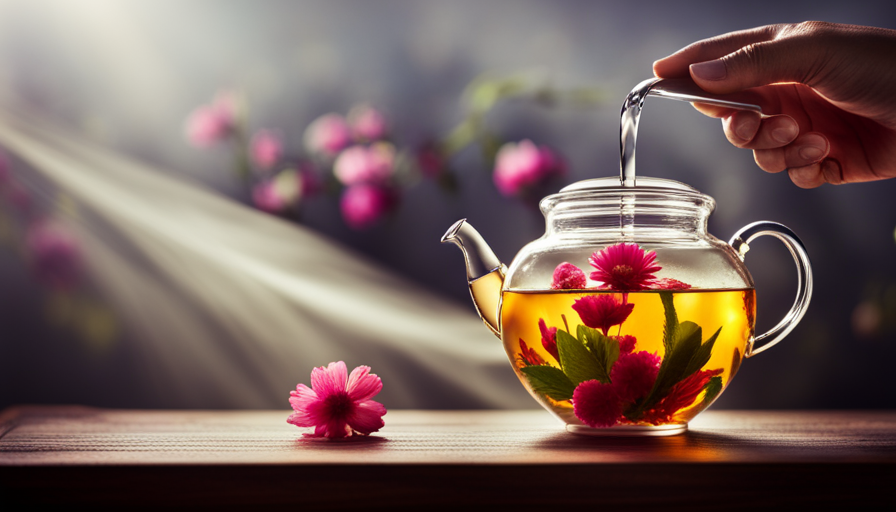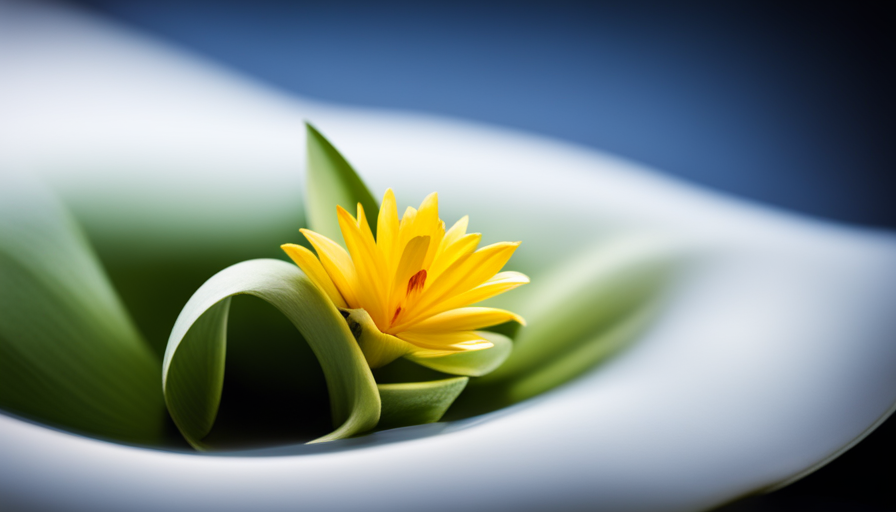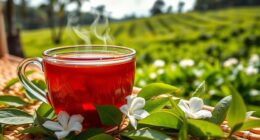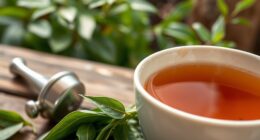If you want to elevate your tea-drinking experience with a touch of sophistication and serenity, then try your hand at crafting dried flower tea. This isn’t your run-of-the-mill cup of tea; it’s a sensory adventure that will whisk you away to a realm of beauty and calmness.
I’ll guide you through the simple yet magical process of creating this delightful beverage, ensuring that every sip is infused with the essence of nature’s finest blooms. From selecting the perfect flowers to drying them with utmost care, I’ll share my expertise on how to make the most exquisite dry flower tea.
Whether you’re a tea connoisseur or a novice, this step-by-step guide will empower you to create a cup of tea that is both visually stunning and a treat for the taste buds. Get ready to embark on a floral adventure and discover the enchantment of dry flower tea.
Key Takeaways
- Properly drying the flowers is crucial to preserve their flavors and qualities.
- Different types of tea infusers can be used, such as mesh tea balls, tea filters, and tea strainers.
- The correct amount of dried flowers should be measured for a perfectly balanced tea.
- Steeping time and water temperature may vary depending on the flower used.
Choose the Right Flowers for Tea Making
Before you start making dry flower tea, make sure to choose the right flowers that’ll fill your cup with delightful flavors and vibrant colors. Drinking flower tea has numerous benefits for your health and well-being. Not only does it provide hydration, but it also contains antioxidants that can boost your immune system and help fight against free radicals.
Different flowers offer various health benefits, so it’s important to choose wisely. One common mistake to avoid when making flower tea is using flowers that’ve been treated with pesticides or chemicals. These can contaminate your tea and have harmful effects on your health. Always opt for organic flowers or ones that’ve been grown without the use of chemicals.
Another mistake to avoid is using flowers that’re past their prime. The best time to harvest flowers for tea is when they’re fully bloomed and vibrant in color. This ensures that you’ll get the most flavor and aroma from your tea.
To transition into the next section about harvesting and drying the flowers properly, it’s important to understand that selecting the right flowers is just the first step. Once you’ve chosen the perfect flowers, it’s time to harvest and dry them to preserve their flavors and qualities.
Harvest and Dry the Flowers Properly
Once you’ve gathered your blossoms, you’ll need to carefully preserve their delicate essence, ensuring a vibrant infusion that will transport you to a serene garden retreat. Proper flower drying techniques are crucial to maintain the flavor and aroma of the flowers in your tea. To begin, gently remove any insects or dirt from the petals. It is important to handle the flowers with care to prevent bruising or damaging them.
Next, choose a drying method that suits your needs. Air drying is a popular method and involves hanging the flowers upside down in a cool, dry place. This allows the flowers to gradually lose moisture while retaining their color and fragrance. Alternatively, you can use a dehydrator or an oven set at a low temperature to speed up the drying process.
To help you visualize the different drying methods, refer to the table below:
| Drying Method | Pros | Cons |
|---|---|---|
| Air drying | Retains color and fragrance, natural method | Takes longer time |
| Dehydrator | Quick drying, consistent results | Requires additional equipment |
| Oven drying | Fast method, accessible | Risk of overheating and loss of flavor |
Properly dried flowers can be stored in airtight containers in a cool, dark place for up to a year. This ensures that they retain their potency and are ready for brewing whenever you desire a soothing cup of dry flower tea.
Store the Dried Flowers in a Safe Place
Find a secure spot in your home where you can store the dried blossoms, preserving their delicate fragrance and ensuring they’re always within reach for a comforting cup of floral infusion.
Proper storage methods are crucial to preserving the freshness of your dried flower tea. Firstly, choose an airtight container that’s opaque to prevent light exposure, as it can degrade the quality of the flowers. Glass jars with tight-fitting lids work well for this purpose. Make sure the container is clean and dry before placing the dried flowers inside.
Additionally, consider adding a silica gel packet to absorb any residual moisture and maintain the tea’s crispness. Store the container in a cool, dark place, away from direct sunlight, heat, and humidity, as these factors can cause the flowers to lose their potency. A pantry or cupboard is an ideal location.
Remember to label the container with the tea’s name and date of storage for easy reference. With your dried flowers safely stored, you can now prepare your tea infuser or teapot for a delightful brewing experience.
Prepare Your Tea Infuser or Teapot
Get your tea infuser or teapot ready to create a soothing and aromatic infusion. When it comes to making dry flower tea, there are different types of tea infusers available that you can choose from. The most common ones include mesh tea balls, tea filters, and tea strainers. Each type has its own unique features and benefits, so it’s important to choose the one that suits your preferences.
Before using your tea infuser, it’s crucial to properly clean and maintain it. This ensures that your tea is free from any impurities and that the flavors of the dried flowers aren’t compromised. To clean your tea infuser, start by rinsing it with hot water to remove any residue. Then, use a mild detergent or dish soap to gently scrub away any stubborn stains. Rinse thoroughly and let it air dry before using it again.
Now that you have your tea infuser or teapot ready, it’s time to move on to the next step – measuring the correct amount of dried flowers. By doing so, you can ensure that your tea is perfectly balanced and not too overpowering.
Measure the Correct Amount of Dried Flowers
To ensure a perfectly balanced and aromatic infusion, you’ll want to carefully measure the ideal amount of dried flowers for your tea. Measuring tips are essential in achieving the desired strength and flavor in your dry flower tea.
The amount of dried flowers you use will depend on personal preference and the specific flowers you’re using. As a general guide, you can start with one teaspoon of dried flowers per cup of water. However, if you prefer a stronger tea, you can increase the amount slightly. It’s important not to overcrowd your tea infuser or teapot, as this can result in a bitter taste.
Dry flower tea offers numerous benefits, including antioxidants, vitamins, and minerals that can support overall health and well-being. Additionally, the natural aromas and flavors of the dried flowers can provide a soothing and calming effect. By carefully measuring the correct amount of dried flowers, you can ensure that you’re enjoying the full benefits of this delightful beverage.
Now that you’ve measured the correct amount of dried flowers, it’s time to move on to the next step: boiling water to the right temperature. This is crucial for extracting the flavors and aromas from the dried flowers and creating a perfect cup of dry flower tea.
Boil Water to the Right Temperature
Start by heating the water to the perfect temperature for extracting the rich flavors and aromas of the dried flowers in your infusion. Choosing the right temperature is crucial to ensure that the delicate flavors of the flowers aren’t destroyed. Ideally, the water should be heated to a temperature between 176°F (80°C) and 203°F (95°C).
This range allows for the optimal extraction of the flowers’ essence without scorching or overcooking them. Monitoring the water temperature is essential during this process. Using a thermometer can help you accurately gauge the temperature and make adjustments as needed. Keep a close eye on the thermometer, as the water temperature can change quickly. If the water becomes too hot, you can let it cool down for a few minutes before proceeding.
Once the water has reached the desired temperature, you’re ready to move on to the next step: steeping the dried flowers in hot water. This’ll allow the flavors and aromas to infuse into the water, creating a soothing and fragrant tea.
Steep the Dried Flowers in Hot Water
Once you’ve reached the perfect temperature, immerse the dried flowers in hot water and let them steep, allowing their essence to bloom and dance like a symphony in your cup. Brewing dry flower tea is an art that offers a delightful sensory experience and numerous health benefits. There are different brewing methods to explore, each bringing out unique flavors and aromas. To help you navigate this world of floral infusions, here is a useful table that showcases some popular dried flowers and their characteristics:
| Dried Flower | Flavor Profile | Health Benefits |
|---|---|---|
| Chamomile | Mild, apple-like | Promotes relaxation |
| Lavender | Floral, sweet | Aids in sleep |
| Rose | Fragrant, fruity | Boosts immune system |
| Hibiscus | Tangy, tart | Lowers blood pressure |
| Peony | Delicate, floral | Supports digestion |
Steeping time and water temperature may vary depending on the flower. Generally, steeping for 5-10 minutes with water just below boiling point is recommended. Dry flower teas offer a plethora of health benefits, including stress reduction, improved sleep, and enhanced digestion. Now that the floral essence has been extracted, it’s time to strain the tea and serve, revealing a captivating blend that will nourish your senses and uplift your spirit.
Strain the Tea and Serve
Now that the exquisite essence of the dried flowers has been fully infused, it’s time for you to carefully strain the tea, allowing the vibrant hues and delicate aromas to gracefully pour into your awaiting cup, ready to be savored and enjoyed.
To do this, place a fine-mesh strainer over your tea cup or teapot and slowly pour the infused tea through it. The strainer will catch any remaining flower petals or debris, ensuring a smooth and pure tea experience.
Take a moment to appreciate the beautiful color of the tea as it fills your cup. The infusion time may vary depending on the type of dried flowers you used, but generally, steeping for 5-10 minutes should be sufficient to extract the flavors and health benefits. The longer you steep, the stronger the flavor will be, so feel free to adjust the time to your preference.
Once you have strained the tea, it’s time to savor its goodness. Take a moment to inhale the delightful aroma that wafts from your cup. The dried flowers impart not only a delicate floral scent but also a range of health benefits, such as promoting relaxation, aiding digestion, and boosting immunity.
With your cup of freshly strained dried flower tea in hand, you can now move on to the next step of adding sweeteners or enhancements (optional).
Add Sweeteners or Enhancements (Optional)
To enhance the flavor of your infused creation, consider adding a splash of honey or a sprinkle of cinnamon for a touch of warmth and sweetness. Sweeteners can elevate the taste of your dry flower tea, making it even more enjoyable.
Here are some sweetener options to consider:
-
Honey: Known for its natural sweetness, honey can add a delicate and floral taste to your tea. It also offers various health benefits, such as soothing a sore throat and boosting the immune system.
-
Stevia: If you prefer a calorie-free sweetener, stevia is a great option. Derived from the stevia plant, this natural sweetener adds a subtle sweetness without the added calories.
-
Agave nectar: With its low glycemic index, agave nectar is a popular choice for those looking for a healthier alternative to processed sugar. It provides a mild and slightly fruity flavor to your tea.
-
Maple syrup: If you enjoy a hint of richness and depth in your tea, try adding a small amount of maple syrup. Not only does it add sweetness, but it also contains beneficial antioxidants.
By adding these sweeteners, you can customize your dry flower tea to your liking while enjoying the added health benefits they offer.
Now that your tea is sweetened to perfection, let’s move on to the next section and learn how to enjoy your homemade dry flower tea.
Enjoy Your Homemade Dry Flower Tea
Savor the delightful flavors and soothing aroma of your handcrafted infusion as you indulge in the pleasure of enjoying your own creation. Making dry flower tea not only allows you to create a beverage tailored to your taste preferences but also provides numerous health benefits. Dry flower tea is packed with antioxidants, vitamins, and minerals that can boost your immune system, improve digestion, and promote relaxation.
To make your dry flower tea even more enjoyable, consider trying out some creative ways to use dry flowers. For example, you can mix different types of dry flowers to create unique flavor combinations. Lavender and chamomile make a relaxing blend, while rose petals and hibiscus flowers add a touch of sweetness. You can also experiment with adding other ingredients like citrus peels, ginger, or cinnamon for an extra kick of flavor.
To help you get started on your dry flower tea journey, here’s a table showcasing some popular dry flowers and their health benefits:
| Dry Flower | Health Benefits |
|---|---|
| Lavender | Calming and promotes sleep |
| Chamomile | Relieves anxiety and stress |
| Rose petals | Rich in antioxidants |
| Hibiscus | Lowers blood pressure |
| Peppermint | Aids digestion and relieves nausea |
So why not treat yourself to a cup of homemade dry flower tea and experience the wonderful flavors and health benefits it has to offer?
Frequently Asked Questions
Can I use any type of flower to make dry flower tea?
Different types of flowers can be used to make delicious dry flower tea. The options are endless, from delicate chamomile blossoms to fragrant lavender buds. However, it’s important to properly prepare the flowers before making the tea. First, ensure that the flowers are pesticide-free and completely dry. Gently remove any stems or leaves, and crush the petals slightly to release their flavors. Now you’re ready to brew a soothing cup of floral goodness!
How long should I let the flowers dry before using them to make tea?
To properly dry flowers for tea, it’s important to allow them to fully dry before use. This ensures that the flowers retain their flavor and medicinal properties. The drying time can vary depending on the type of flower and the drying method used. Generally, it takes about 1-2 weeks for flowers to completely dry.
Using dried flowers in tea offers numerous benefits, such as enhancing the flavor, adding fragrance, and providing potential health benefits from the flowers’ natural compounds.
What is the best way to store dried flowers for making tea?
The key to preserving dried flowers for tea lies in choosing the right containers and techniques. I recommend using airtight glass jars, as they not only keep the flowers fresh but also allow you to admire their vibrant colors.
To preserve the aroma and flavor, store the jars in a cool, dark place, away from sunlight and moisture. Additionally, adding a silica gel packet can help absorb any excess moisture, ensuring the flowers remain fragrant and delicious for longer.
Can I use a regular tea bag instead of a tea infuser or teapot?
Yes, you can definitely use a regular tea bag as an alternative to a tea infuser or teapot when making dry flower tea or other types of herbal tea. Tea bags are convenient and widely available. Simply fill the tea bag with your desired dry flowers, seal it, and steep it in hot water. The tea bag acts as a filter, allowing the flavors and benefits of the flowers to infuse into the water. It’s a simple and effective method for enjoying your herbal tea.
How much water should I boil for making dry flower tea?
To make a delicious and aromatic dry flower tea, start by bringing a pot of water to a rolling boil. As the water bubbles and dances like a pot of gold, measure out the desired amount based on your preference and the number of cups you want to make. Remember to leave some room for the flowers to expand.
Once the water’s boiled, let it cool slightly before pouring it over the dry flowers and allowing them to steep for the recommended time.
Conclusion
So there you have it, my dear tea enthusiasts! After carefully choosing the perfect flowers, mastering the art of drying and storing them, and steeping them to perfection, you’re now ready to savor the enchanting flavors and aromas of your homemade dry flower tea.
Don’t hesitate to experiment with sweeteners or enhancements to elevate your tea-drinking experience. So go ahead, indulge in the beauty and tranquility of nature’s bounty, and sip on this delightful elixir that’ll surely warm your heart and soothe your soul.
Cheers to your tea-making success!

